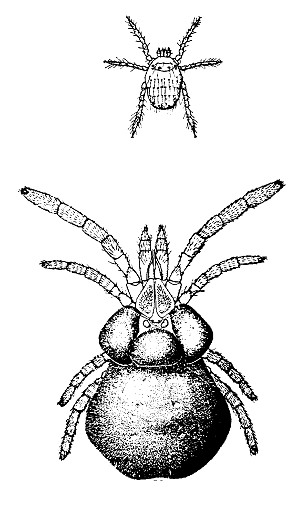Chiggers, Jiggers, Harvest Mites, or Red Bugs
 Scientific Name
Scientific Name
Trombicula sp.
Hosts
Chiggers feed on humans, as well as a wide variety of snakes, turtles, birds, and small mammals.
Description
Chigger mites are small (1/20 to 1/64 inch long), orange, yellow or light red (usually bright red), and have hairy bodies. The larval stage has three pairs of legs, the nymph and adult four pairs. The larval stage of the mite is the only parasitic stage.
Life Cycle
Adult mites overwinter in soil and other protected places and emerge in spring to lay eggs. After hatching, chigger larvae climb up onto vegetation from which they can attach themselves to a passing host. After engorgement, often requiring one to several days, larvae drop off the host and transform into eight-legged nymphs which mature to the adult stage. The life cycle is about 2 months, with adult females living up to one year producing multiple generations. Chiggers are usually encountered in late spring and summer in woodlots, pastures, roadside ditches or other areas with tall grasses and weeds. They lurk near the top of grass stems, leaves, shrubbery, etc., usually in damp, shaded spots. Young chiggers attach themselves to the skin of people, domestic animals, wild animals (including reptiles), poultry and birds. Once on the host, chiggers migrate to parts of the body where clothing fits tightly over the skin such as around the belt line, waistline, and under socks, or where the flesh is thin, tender or wrinkled such as the ankles, in the armpits, back of the knees, in front of the elbow, or in the groin.
Chigger larvae do not burrow into the skin, nor suck blood. They pierce the skin and inject a salivary secretion containing digestive enzymes that break down skin cells that are sucked up. After a larva is fully fed (3-4 days) it drops from the host, leaving a red welt. Any welts, swelling, itching, or fever will usually develop three to six hours after exposure and may continue for several weeks. Scratching a bite may break the skin, resulting in secondary infections.
Control
The best defense against chiggers is to avoid or repel them. Before going into an area where chiggers may be present, protect yourself by using a repellent containing DEET or permethrin. Wear loose fitting clothing that is made of tightly woven material. Remove and launder clothing as soon as possible after exposure to the chiggers. A warm shower taken within an hour or two after exposure greatly reduces the number of irritating bites. If the itching has started, though, it is too late for bathing to do much good. Please contact your local county extension office for current information.

